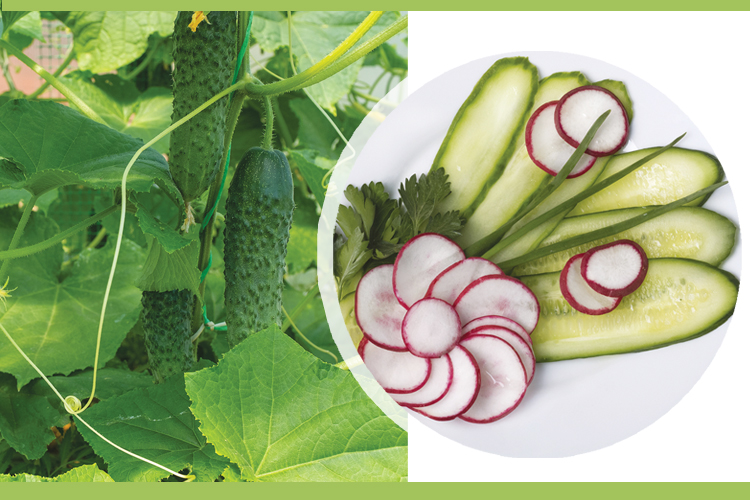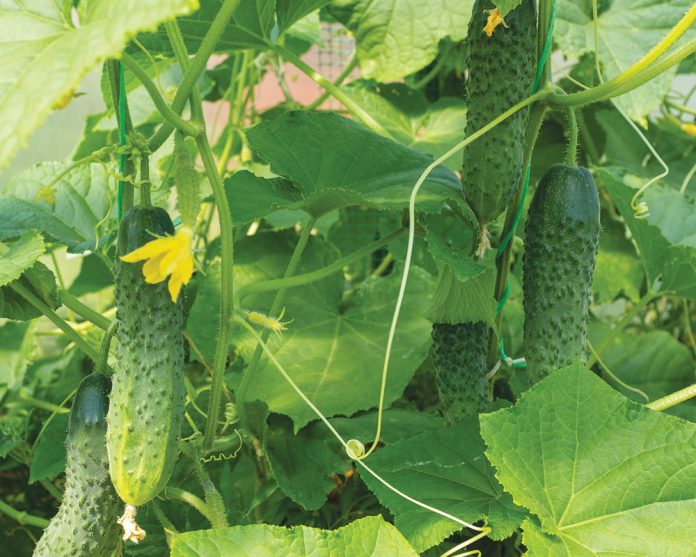
As the summer warms up, the heat-loving crops begin producing in earnest. Chief among them are cucumbers, a home-garden staple, versatile in the kitchen. Here’s how to get the most from your harvest!
To protect and maximize your crop :
Consider trellising : Keeping cucumber vines on a trellis, garden border fence, or even in a pot can save ground space, deter pests, and make harvesting much easier. Every year, I discover at least a couple monster cucumbers that have gone unnoticed behind a leaf. The pretty yellow cucumber flowers attract many pollinators, which is good for the whole garden. In my experience, cucumbers do not always do well in pots, but they may if you have a railing or other nearby structure for the vine to climb.
Watch the weather : Here on Long Island, we love to talk about the weather because it can be unpredictable, particularly during spring and early fall. It’s also critical when it comes to vegetable gardens. Cucumbers love water and have a high water content, but they’re also susceptible to a variety of water-linked ailments, such as downy or powdery mildew. The easiest way to avoid these diseases is to target watering at the base of the plant, rather than the leaves, and water in the morning. Watering in the evening often results in the plant being wet overnight, allowing fungus to take hold.
Guard against squash vine borers : If you’ve ever had a cucumber vine wilt and stay wilted despite plenty of water, you probably had a squash vine borer. The larva hatch from eggs laid on the leaves or at the base of the vine, and “bore” into the vine itself, eating its way along. They leave behind a tell-tale pile of “sawdust” at the base of the plant. Unless you catch the larva early on and perform plant surgery to extract it, the vine is a lost cause. I take a three-pronged approach to protect my crop while keeping things organic. 1.) Squash vine borer traps (hung nearby, per manufacturer instructions), to attract the moths before they’ve had a chance to lay eggs. 2.) Use Diatomaceous Earth regularly at the base of the plants to prevent hatching. 3.) Be vigilant in your visual inspection for and removal of eggs. Black pepper can be used as a substitute for Diatomaceous Earth in a pinch. Note: These borers also target zucchini, and these strategies work well.
Enjoy the fruits of your labor!
- Make homemade pickles (and fried pickles!): My favorite pickle recipes are done using a mason jar, stored in the fridge and are ready within a couple of days. No complicated sterilizing/canning needed! Enjoy as spears or chips.
- Cucumber salad: Experiment with mustard and vinegar or mayo bases. Switch out white onions for red or omit onions entirely. If possible, sweat the cucumbers before incorporating into the salad, and let the salad sit awhile before serving. The flavors will meld and be greatly enhanced.
- Fresh cucumbers, sliced, dressed, or dipped: Enjoy cucumbers on their own, sliced over a garden salad, or dipped in your favorite spread.
- Cucumber-infused cocktails: Muddle into your drink to add a subtle, refreshing summer taste, use as a garnish, or try a homemade-infusion with your favorite vodka (or other libation of choice).
Cucumbers are the quintessential summer vegetable, and with so many ways to enjoy, you’ll easily use up everything you worked hard to grow in no time!












 20 lucky winners will win $500 each in prizes totaling $10,000.
20 lucky winners will win $500 each in prizes totaling $10,000. 